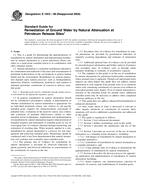1.1 This is a guide for determining the appropriateness of remediation by natural attenuation and implementing remediation by natural attenuation at a given petroleum release site, either as a stand alone remedial action or in combination with other remedial actions.
1.2 Natural attenuation is a potential remediation alternative for containment and reduction of the mass and concentration of petroleum hydrocarbons in the environment to protect human health and the environment. Remediation by natural attenuation depends upon natural processes such as biodegradation, dispersion, dilution, volatilization, hydrolysis, and sorption to attenuate petroleum constituents of concern to achieve remedial goals.
Note 1 – Remedial goals must be established through another process as determined by the appropriate regulatory agency.
1.3 In general, remediation by natural attenuation should not be considered a presumptive remedy. A determination of whether remediation by natural attenuation is appropriate for an individual petroleum release site, relative to site-specific remedial goals, requires site characterization, assessment of potential risks, evaluation of the need for source area control, and evaluation of potential effectiveness similar to other remedial action technologies. Application and implementation of remediation by natural attenuation requires demonstration of remedial progress and attainment of remedial goals by use of converging lines of evidence obtained through monitoring and evaluation of resulting data. When properly applied to a site, remediation by natural attenuation is a process for risk management and achieving remedial goals. Monitoring should be conducted until it has been demonstrated that natural attenuation will continue and eventually meet remedial goals.
1.3.1 The primary line of evidence for remediation by natural attenuation is provided by observed reductions in plume geometry and observed reductions in concentrations of the constituents of concern at the site.
1.3.2 Secondary lines of evidence for remediation by natural attenuation are provided by geochemical indicators of naturally occurring degradation and estimates of attenuation rates.
1.3.3 Additional optional lines of evidence can be provided by microbiological information and further analysis of primary and secondary lines of evidence such as through solute transport modeling or estimates of assimilative capacity.
1.4 The emphasis in this guide is on the use of remediation by natural attenuation for petroleum hydrocarbon constituents where ground water is impacted. Though soil and ground water impacts are often linked, this guide does not address natural attenuation in soils separate from ground water or in situations where soils containing constituents of concern exist without an associated ground water impact. Even if natural attenuation is selected as the remedial action for ground water, additional remedial action may be necessary to address other completed exposure pathways at the site.
1.5 This guide does not address enhanced bioremediation or enhanced attenuation.
1.6 Also, while much of what is discussed is relevant to other organic chemicals or constituents of concern, these situations will involve additional considerations not addressed in this guide.
1.7 The guide is organized as follows:
1.7.1 Section 2 lists referenced documents.
1.7.2 Section 3 defines terminology used in this guide.
1.7.3 Section 4 describes the significance and use of this guide.
1.7.4 Section 5 provides an overview of the use of natural attenuation as a remedial action alternative, including;
1.7.4.1 Advantages of remediation by natural attenuation as a remedial alternative;
1.7.4.2 Limitations of remediation by natural attenuation as a remedial alternative; and
1.7.4.3 Using multiple lines of evidence to demonstrate the appropriateness of remediation by natural remediation.
1.7.5 Section 6 describes the decision process for appropriate application and implementation of remediation by natural attenuation including;
1.7.5.1 Initial response, site characterization, selection of chemicals of concern, and establishment of remedial goals;
1.7.5.2 Evaluation of plume status;
1.7.5.3 Collection and evaluation of additional data;
1.7.5.4 Comparing remediation by natural attenuation performance to remedial goals;
1.7.5.5 Comparing remediation by natural attenuation to other remedial options;
1.7.5.6 Implementation of a continued monitoring program;
1.7.5.7 Evaluation of progress of remediation by natural attenuation; and
1.7.5.8 No further action.
1.7.6 Section 7 lists keywords relevant to this guide.
1.7.7 Appendix X1 describes natural attenuation processes;
1.7.8 Appendix X2 describes site characterization requirements for evaluating remediation by natural attenuation;
1.7.9 Appendix X3 describes considerations for designing and implementing monitoring for remediation by natural attenuation;
1.7.10 Appendix X4 describes sampling considerations and analytical methods for determining indicator parameters for remediation by natural attenuation;
1.7.11 Appendix X5 describes the interpretation of different lines of evidence as indicators of natural attenuation;
1.7.12 Appendix X6 describes methods for evaluation and quantification of natural attenuation rates; and
1.7.13 Appendix X7 describes example problems illustrating the application and implementation of remediation by natural attenuation.
1.8 This standard does not purport to address all of the safety concerns, if any, associated with its use. It is the responsibility of the user of this standard to establish appropriate safety and health practices and determine the applicability of any regulatory limitations prior to use.
Product Details
- Published:
- 05/01/2004
- Number of Pages:
- 43
- File Size:
- 1 file , 830 KB
